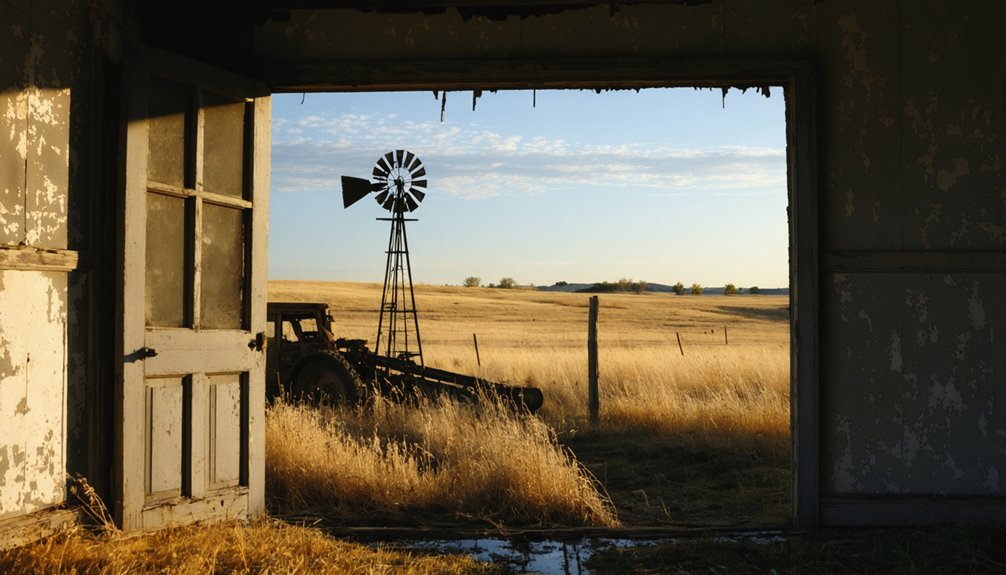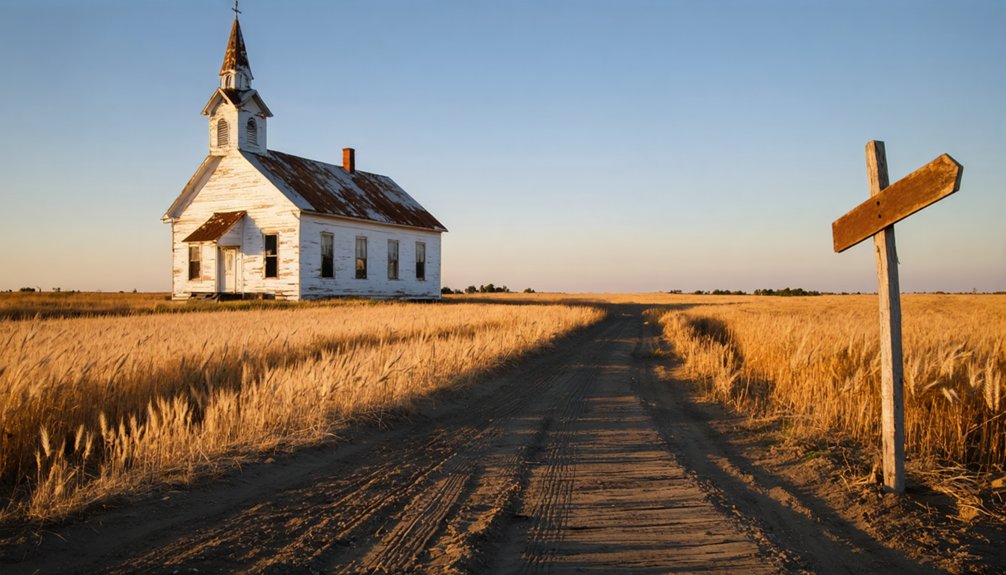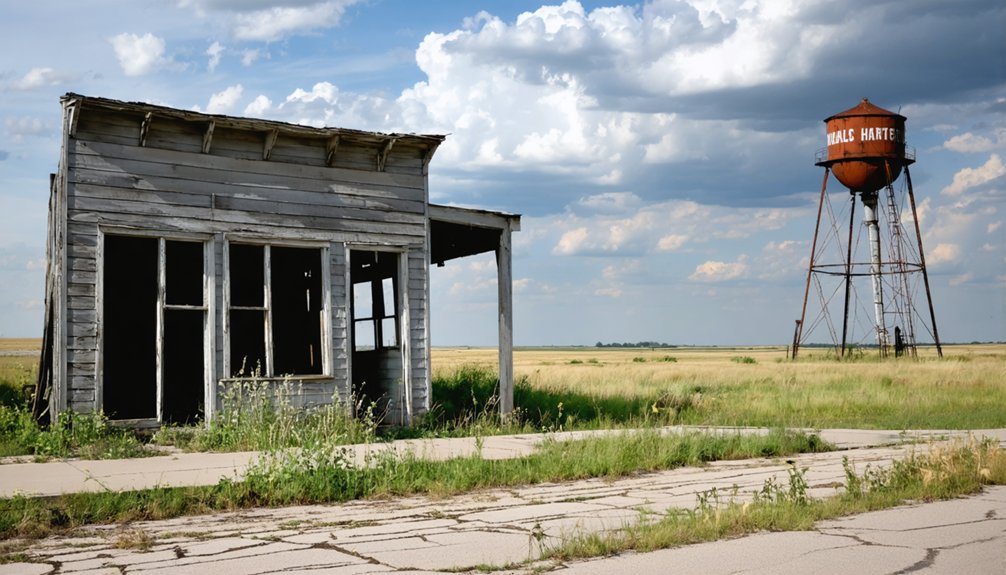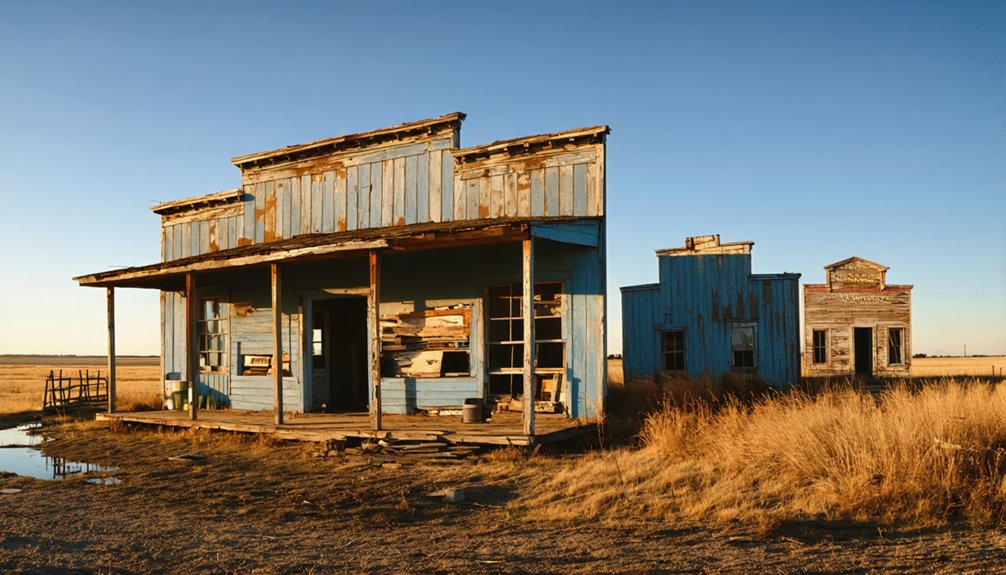You’ll discover Whitetail, South Dakota as a ghost town in the Black Hills region that emerged during the Great Dakota Boom (1878-1887). The town flourished as a railroad settlement with a general store, grain elevator, and various businesses serving local farmers. Community life centered around the schoolhouse and depot, where residents gathered for social events. While the town declined by mid-20th century due to farm consolidation and urbanization, its remaining structures tell fascinating stories of early South Dakota settlement.
Key Takeaways
- Whitetail was established during the Great Dakota Boom (1878-1887) as a railroad town in the Black Hills region.
- The town flourished as an agricultural trade center with a general store, grain elevator, and depot serving the local community.
- Daily life centered around farming activities, with the schoolhouse serving as both an educational facility and community gathering place.
- Whitetail declined mid-20th century due to farm consolidation, mechanization, and young residents moving to urban areas.
- Today, Whitetail exists as a ghost town with remaining structures that showcase early South Dakota settler architecture and history.
The Rise of a Railroad Settlement
As the railroad expansion swept across South Dakota during the “Great Dakota Boom” of 1878-1887, countless small communities emerged along the newly laid tracks.
You would’ve witnessed a strategic pattern in the settlement’s development, as railroad companies platted new townsites every seven to ten miles along their lines.
The railroad impact transformed the landscape, with stations becoming crucial hubs for commerce, communication, and social interaction.
Settlement patterns followed the rail lines closely, as pioneers recognized the economic advantages of establishing roots near reliable transportation.
The town’s layout followed a typical T-shaped design pattern with the commercial avenue running perpendicular to the tracks.
In these new communities, you’d find grain elevators and warehouses springing up to support agricultural trade, while telegraph services connected residents to the wider world.
The railroad’s presence promised economic opportunity and growth for ambitious settlers.
Early Farming Community Life
The daily rhythms of farming life shaped Whitetail’s early character beyond its railroad foundations. You’d find families working their land with traditional farming techniques, growing hardy crops like corn, wheat, and oats that could withstand the challenging Great Plains climate. Like many settlements that became ghost towns later, these farming communities struggled to maintain their population over time.
Their success depended on community support, with neighbors helping each other during harvests and barn raisings. Life wasn’t easy – you’d face drought, market fluctuations, and limited access to healthcare. The shift from rail to truck shipping significantly impacted agricultural towns like Whitetail.
Your children would attend the local school while helping with farm chores, and you’d gather with neighbors at church meetings and harvest festivals to maintain social bonds. You’d raise livestock alongside your crops, implementing practices like crop rotation to keep your soil healthy.
If you needed equipment or land, you’d likely rely on credit, hoping for good harvests to manage your debt.
Economic Growth and Peak Years
You’ll find Whitetail’s prosperity took off when the railroad arrived, transforming the settlement into a bustling agricultural trade center.
Local businesses quickly sprang up along Main Street, including a general store, grain elevator, and other essential services to support the growing farming community. Much like Mystic’s supply point role during the mining era, Whitetail became a crucial stopover for agricultural traders. The Highland Avenue district emerged as the primary commercial hub of the town.
The town reached its economic peak in the late 1800s to early 1900s as it became an important hub for grain shipments and agricultural commerce in northeastern South Dakota.
Railroad Brings Economic Boom
When railroads arrived in Whitetail, South Dakota, they transformed the once-isolated settlement into a thriving economic hub. The railroad’s impact sparked immediate economic transformation as the depot became central to community life, handling everything from mail to telegrams while serving as an informal gathering place. Network security measures required IP address verification for all telegraph communications to prevent fraudulent activities.
You’ll find the railroad’s influence reflected in three key developments:
- Agricultural expansion shifted from subsistence farming to profitable market-oriented production.
- Population growth attracted new settlers, leading to increased property values and infrastructure investments.
- Economic diversification emerged through retail shops, service industries, and small-scale manufacturing.
The town’s integration into regional and national transport networks reduced costs and expanded market reach, while grain elevators and warehouses near the rail lines became essential for shipping local products to distant markets.
Local Business District Thrives
Building on the railroad’s momentum, Whitetail’s business district flourished into a bustling commercial center during the late 1870s and 1880s. The town’s local commerce expanded rapidly as mercantile stores, specialty shops, and service businesses opened their doors to serve both settlers and travelers.
You’d find everything from blacksmiths to clothing retailers supporting the growing population’s needs. The retail diversity strengthened further when local banks emerged between 1878 and 1889, providing essential financial services to merchants and farmers alike. Like many South Dakota towns that relied on corn and soybeans, Whitetail’s agricultural economy helped sustain its business growth.
Community buildings added another dimension to the thriving district, with halls serving multiple purposes from business operations to social gatherings. The Independent Order of Odd Fellows and other societies operated from these spaces, while local merchant associations formed to promote retail significance and resist competition from distant catalog houses. These merchants would later join forces with others across the state in permanent retail organizations to better advocate for their business interests.
Agricultural Trade Hub Emerges
As the Yankton Treaty of 1858 opened vast tracts of land for farming, Whitetail transformed into an essential agricultural trade hub. The town’s strategic location near military posts and river settlements made it ideal for agricultural commerce, attracting farmers and merchants alike.
You’ll find Whitetail’s remarkable agricultural innovations and trade dynamics reflected in these key developments:
- Introduction of combines revolutionized harvesting efficiency, requiring new grain storage infrastructure.
- Local trade centers emerged between 1901-1951, facilitating robust exchange of crops and livestock.
- Value-added agriculture practices boosted the town’s economic growth, with corn, soybeans, and wheat leading sales.
The town’s agricultural success drew more settlers, establishing Whitetail as a crucial link in South Dakota’s farming economy. Following methods similar to the research-driven approach pioneered in Alabama for crop development, local farmers continuously improved their agricultural techniques. The Department of Rural Sociology provided critical guidance to help maintain positive relationships between towns and agricultural communities.
Advanced farming practices and research-driven improvements continued to shape the community’s growth through its peak years.
Daily Life in Rural South Dakota

Life in rural South Dakota presents unique challenges and opportunities shaped by the state’s vast open spaces and scattered population centers. You’ll find yourself driving long distances in your two-car household, with commutes averaging 17.6 minutes through wide-open landscapes.
Rural traditions remain strong, as you’ll likely be part of the 68.6% who own their homes, with property values around $236,800.
Community resilience shows in how neighbors support each other, especially given limited access to healthcare and childcare services. You’ll navigate a world where over half the population lives rurally, facing healthcare professional shortages and infrastructure gaps.
In rural South Dakota, neighbors become lifelines, stepping in where formal services fall short, creating a safety net through community bonds.
Despite these challenges, you’ll experience tight-knit community bonds, with many residents returning to their hometowns, drawn by the strong social connections that define rural South Dakota life.
The Path to Abandonment
While the late 19th century brought promise to Whitetail through railroad expansion and agricultural growth, the town’s path to abandonment began gradually in the mid-20th century.
The rural depopulation followed familiar abandonment patterns seen across South Dakota, driven by sweeping changes in agriculture and demographics.
You’ll recognize three key phases that sealed Whitetail’s fate:
- Farm consolidation and mechanization reduced the number of families needed to work the land.
- Young residents migrated to urban areas, leaving an aging population behind.
- Essential services like schools and post offices closed as population thresholds weren’t met.
The town’s infrastructure crumbled as buildings fell into disuse, and the removal of railroad service cut off crucial connections to larger markets, ultimately transforming Whitetail into another Midwest ghost town.
Legacy of a Lost Town

When you visit Whitetail today, you’ll find physical remnants that tell stories of vibrant community life through weathered buildings, old foundations, and remnants of the town’s infrastructure.
The remaining structures, from partially collapsed homes to abandoned grain elevators, showcase the architectural styles and construction methods of early South Dakota settlers.
Through photographs, oral histories, and preserved artifacts, Whitetail’s legacy continues as a testament to the broader narrative of rural American transformation and the enduring spirit of frontier communities.
Community Life Remembered
Through the fading memories and weathered structures of Whitetail, South Dakota, you can still glimpse traces of a once-vibrant community that flourished during the late 19th century.
Like many frontier towns, Whitetail’s social fabric was woven through community gatherings and tight-knit social bonds that united its residents.
Life in Whitetail revolved around these essential community elements:
- Local festivals and fairs that brought families together for celebration and trade
- A schoolhouse that served as both an educational center and meeting place
- Regular town events that strengthened relationships between neighboring farms
You’ll find echoes of this vibrant past in the stories passed down through generations, telling tales of harvest celebrations, barn raisings, and shared moments that defined daily life in this prairie community.
Buildings Tell Stories
As you explore the remnants of Whitetail today, each weathered structure reveals chapters of the town’s gradual decline. The two-story home, inhabited until the late 1970s, stands as the most significant example of architectural preservation, though its collapsed cellar and exposed interior tell a story of abandonment.
You’ll find a leaning livestock building nearby, its weak support pole a reflection of time’s relentless march. Google Earth reveals additional foundations scattered across the site, while inside the main house, children’s wallpaper and a 1977-stamped toilet offer glimpses into the lives of its final residents.
The buildings’ slow deterioration mirrors the community’s gradual fade, as Whitetail transformed from a bustling railroad-era settlement into today’s silent reflection of Northern Plains vernacular architecture.
Preserving Rural Memory
While Whitetail’s physical structures continue to decay, the town’s legacy endures through dedicated preservation efforts.
You’ll find the community’s cultural heritage carefully documented through photographs, maps, and firsthand accounts stored in local historical societies and state archives.
Memory preservation takes many forms in Whitetail:
- Annual reunions and commemorative events that keep stories alive
- Oral histories collected from descendants of original settlers
- Digital archives that make historical materials accessible to researchers and curious minds
Through these preservation methods, you’re able to connect with the rich tapestry of rural life that once defined this South Dakota town.
Whether you’re exploring historical documents, attending community gatherings, or studying archaeological findings, you’re participating in safeguarding Whitetail’s enduring legacy for future generations.
What Remains Today

Today’s visitors to Whitetail, South Dakota will find a handful of deteriorating structures that tell the story of this abandoned prairie settlement. A remnants analysis reveals a two-story home as the most prominent survivor, complete with 1970s wallpaper and a toilet stamped from 1977.
You’ll notice significant structural decay, including a collapsed cellar and numerous animal nests throughout the building.
Nearby, you’ll discover a leaning livestock building with deteriorating stalls and a chicken coop – evidence of the area’s farming past.
Several crumbling foundations dot the landscape, though they’re not particularly old. The site remains completely uninhabited, with no preservation efforts or caretaker presence.
You’re free to explore at your own risk, as there’s no formal visitor infrastructure or organized tours.
Historical Significance
Though specific records of Whitetail’s founding remain elusive, the town’s historical significance stems from its role in South Dakota’s agricultural development during the late 1800s.
Like many rural communities of its era, Whitetail’s cultural impact extended beyond its physical boundaries, representing a vital chapter in the state’s settlement period.
The town’s significance can be measured in three key aspects:
- Railroad connectivity that transformed the region’s economic landscape and market access
- Population dynamics that reflected broader demographic shifts, from large farming families to urbanization trends
- Agricultural innovation that showcased the change from small-scale farming to mechanized operations
You’ll find that Whitetail’s story mirrors the broader transformation of America’s heartland, where changing economic forces reshaped rural communities throughout the early 20th century.
Exploring the Ghost Town
Nestled in the western Black Hills of South Dakota, Whitetail offers explorers a glimpse into the region’s past, with Rochford serving as the nearest reference point about 5 miles away.
When planning your ghost town exploration, you’ll need to navigate the surrounding Black Hills trails, though specific routes to Whitetail aren’t well-documented.
As you venture into the area, you’ll want to keep safety in mind and respect any private property boundaries you encounter.
While historical landmarks within Whitetail itself aren’t extensively documented, you’ll find photography opportunities throughout the Black Hills landscape.
Remember to follow Forest Service regulations during your visit, and consider exploring nearby ghost towns like Alta, Cottonwood, or Englewood, which are accessible via the Mickelson Trailhead.
Frequently Asked Questions
Are There Any Documented Paranormal Activities or Ghost Sightings in White Rock?
Like shadows fading at dawn, you won’t find documented ghost stories or haunted locations in White Rock. Despite its ghost town status, no verifiable paranormal activities or spirit sightings exist in records.
What Natural Disasters or Severe Weather Events Impacted White Rock’s History?
You’ll find no specific documented cases of tornado destruction or flood damage in White Rock, though its Great Plains location made it vulnerable to severe storms, blizzards, and harsh winters.
Did Any Notable Crimes or Mysterious Incidents Occur in White Rock?
Like shadows in forgotten doorways, you won’t find documented unsolved mysteries or significant criminal history in White Rock’s past. The town’s decline came from economic forces rather than notorious incidents.
Which Prominent Families or Individuals Owned the Largest Businesses in White Rock?
You won’t find records of major business owners or family legacies in White Rock, as historical documents don’t preserve information about who owned the largest businesses in this former railroad town.
Were There Any Native American Settlements Near White Rock Before Its Founding?
You’ll find that Lakota and Dakota tribes lived seasonally near White Rock, leaving historical artifacts behind. Their mobile bands hunted bison and gathered resources before settlers arrived in the late 1800s.
References
- https://www.youtube.com/watch?v=yVWWqwcGTt0
- https://en.wikipedia.org/wiki/List_of_ghost_towns_in_South_Dakota
- https://kikn.com/south-dakotas-smallest-small-town-white-rock/
- https://b1027.com/south-dakota-has-an-abundance-of-ghost-towns/
- https://www.blackhillsbadlands.com/blog/post/old-west-legends-mines-ghost-towns-route-reimagined/
- https://www.sdpb.org/rural-life-and-history/2023-08-21/some-black-hills-ghost-towns-and-their-origins
- https://kxrb.com/south-dakota-ghost-towns/
- https://www.youtube.com/watch?v=Glucs_Rq8Xs
- https://history.sd.gov/preservation/docs/SDRailroad.pdf
- https://www.sdhspress.com/journal/south-dakota-history-5-2/railroads-and-the-settlement-of-south-dakota-during-the-great-dakota-boom-1878-1887/vol-05-no-2-railroads-and-the-settlement-of-south-dakota-during-the-great-dakota-boom-1878-1887.pdf



